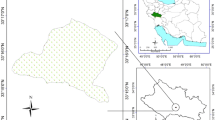Abstract
The dry woodland savannas of Namibia are of significant socio-economic importance. The paper tests the suitability of a number of diversity indicators developed for species poor systems in Europe in the woodland context. The indicators that were tested included the species specific mingling index, M Sp, the measure of surround and the uniform angle index. The simple application of the methods permit relatively unschooled crews to conduct an enumeration in the field. The results show that the indicators do not only display current diversity status, but also reflect the ecological context of the individual species.
Similar content being viewed by others
References
Albert M. and Gadow K.v. 1998. Assessing biodiversity with new neighborhood-based parameters. In: Proceedings of the International Conference on Data Management and Modelling Using Remote Sensing and GIS for Tropical Forest Land Inventory. Jakarta, Indonesia, Oct. 26–29, 1998.
M. Amakali (1992) Updated isohyetal rainfall map for Namibia Department of Water Affairs Namibia
Büschel D. 1999. A study of resource utilization: a case from Namibia, Mpungu constituency, Kavango districtnorthern Namibia. CRIAA SA-DC Report, Windhoek, Namibia.
M. Chakanga (1995) Forest Cover Reconnaissance Mapping Project Directorate of Forestry Republic of Namibia, Windhoek
S.L. Childes (1984) The population dynamics of some woody species in the Kalahari sand vegetation of the Hwange National Park University of the Witwatersrand South Africa
P.J. Clark F.C. Evans (1954) ArticleTitleDistance to Nearest Neighbor as a Measure of Spatial Relationships in Populations Ecology 35 IssueID4 445–453 Occurrence Handle10.2307/1931034
Coetzee M.E. 2001. NAMSOTER, A SOTER database for Namibia. Agroecological Zoning Programme, Ministry of Agriculture, Water and Rural Development, Namibia.
S.E. Crerar J.T. Church (1988) Evaporation map for south West Africa/Namibia Department of Water Affairs Namibia
N.J. Dominy B. Duncan (2001) ArticleTitleGPS and GIS methods in an African rain forest: applications to tropical ecology and conservation Conserv. Ecol. 5 IssueID2 6
InstitutionalAuthorNameDepartment of Water Affairs (1971) Consolidated report on reconnaissance surveys of soils of northern and central south West Africa in terms of their potential for irrigation Department of Water Affairs Windhoek, Namibia
InstitutionalAuthorNameDepartment of Water Affairs (1991) Groundwater investigation in Kavango and Bushmanland, Namibia Department of Water Affairs Windhoek, Namibia
E. Pauw ParticleDe M.E. Coetzee (1999) ArticleTitleProduction of an agro-ecological zones map of Namibia (first approximation), Part 2: Results Agricola 10 8–68
K.v. Gadow (1999) ArticleTitleWaldstruktur und Diversität Alg. Forst-u. J.-Ztg. 170 117–122
K.v. Gadow G.Y. Hui M. Albert (1998) ArticleTitleDas Winkelmass – ein Strukturparameter zur Beschreibung der Individualverteilung in Waldbeständen Centralblatt das gesamte Forstwesen. 115 IssueID1 1–10
K.v. Gadow G.Y. Hui B.W. Chen M. Albert (2003) ArticleTitleBeziehungen zwischen Winkelmass und Baumabständen Forstw. Cbl. 122 127–137 Occurrence Handle10.1046/j.1439-0337.2003.00127.x
W. Giess (1998) ArticleTitleA preliminary vegetation map of Namibia (3rd revised edition) Dinteria 4 1–112
F.P. Graz (1996) Management of a Pterocarpus angolensis population under the influence of fire and land use University of Stellenbosch South Africa
F.P. Graz (1999) ArticleTitleA preliminary terrain feature classification of the Okavango region, Namibia S. Afr. J. Survey. Geo-Inf. 1 123–129
F.P. Graz (2003) ArticleTitleFire damage to Schinziophyton rautanenii (Schinz) trees in North-Eastern Namibia Dinteria 28 39–43
F.P. Graz (2004) ArticleTitleThe behavior of the species mingling index M Sp in relation to species dominance and dispersal Eur. J. Forest Res. 1 87–92 Occurrence Handle10.1007/s10342-004-0016-8
G.Y. Hui M. Albert K.v. Gadow (1998) ArticleTitleDas Umgebungsmaß als Parameter zur Nachbildung von Bestandesstrukturen Forstw. Cbl. 117 258–266 Occurrence Handle10.1007/BF02832980
R.B. Lee (1973) ArticleTitleMogongo: the ethnography of a major wild food resource Ecol. Food Nutr. 2 307–321 Occurrence Handle10.1080/03670244.1973.9990351
S. Leger (1997) The Hidden Gift of Nature DED, German Development Service Berlin, Germany
A. Lewandowski A. Pommerening (1997) ArticleTitleZur Beschreibung der Waldstruktur – Erwartete und beobaachtete Arten-Durchmischung Forstw. Cbl. 116 129–139
Mitlöhner R. 1997. Pflanzeninterne Potentiale als Indikatoren für den tropischen Standort. Shaker Verlag.
J. Newmark (1997) Statistics and Probability in Modern Life EditionNumber6 Sauders College Publishing Fort Worth
InstitutionalAuthorNameNFSP (1996) Namibia Forestry Strategic Plan Directorate of Forestry Windhoek, Namibia
T. Ollikainen (1992) Study on wood consumption in Namibia Directorate of Forestry Windhoek
E.C. Pielou (1977) Mathematical Ecology John Wiley & Sons New York 384
M.C. Rutherford (1981) ArticleTitleSurvival, regeneration and leaf biomass changes in woody plants following spring burns in Burkea africana – Ochna pulchra savanna Bothalia 13 531–552
C.M. Shackleton (2001) ArticleTitleManaging regrowth of an indigenous savanna tree species (Terminalia sericea) for fuelwood: the influence of stump dimensions and post-harvest coppice pruning Biomass Bioenergy 20 261–270 Occurrence Handle10.1016/S0961-9534(00)00086-6
T.M. Smith K. Grant (1986) ArticleTitleThe role of competition in a Burkea africana – Terminalia sericea savanna Biotropica 18 219–223 Occurrence Handle10.2307/2388488
K. Staupendahl (2001) Das flächenbezogene Winkelmass Wf – Ein Index zur quantitativen Beschreibung der horizontalen Baumverteilung A. Akca (Eds) et al. WaldinventurWaldwachstum und Forstplanung – Moderne Technologien, Methoden und Verfahrensweisen. Festschrift K. von Gadow Zohab-Verlag Göttingen 101–115
W.J. Vermeulen (1990) A monograph on Pterocarpus angolensis SARCCUS Standing Committee for Forestry Pretoria, South Africa
Von Breitenbach F. 1968. Long-term plan of forestry development in eastern Caprivi Zipfel. Unpublished Report. George, South Africa.
B.G. Wilson E.T.F. Witkowski (2003) ArticleTitleSeed banks bark thickness and damage in age and size structure (1978–1999) of the African savanna tree Burkea africana Plant Ecol. 167 151–162 Occurrence Handle10.1023/A:1023999806577
R.I. Yeaton (1988) ArticleTitlePorcupines, fires and the dynamics of the tree layer of the Burkea africana savanna J. Ecol. 76 1017–1029
Author information
Authors and Affiliations
Corresponding author
Rights and permissions
About this article
Cite this article
Graz, F.P. Spatial Diversity of Dry Savanna Woodlands. Biodivers Conserv 15, 1143–1157 (2006). https://doi.org/10.1007/s10531-004-3105-6
Received:
Accepted:
Issue Date:
DOI: https://doi.org/10.1007/s10531-004-3105-6




